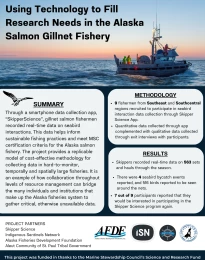Abstract
In Alaska, most hatchery salmon production occurs with Pink Salmon in Prince William Sound and Chum Salmon in Southeast Alaska. These hatcheries are operated by private non-profit organizations and follow state regulations to minimize impact to wild populations. State law requires use of local broodstock and selection of release sites away from significant wild populations, among other measures. In both Prince William Sound (PWS) and Southeast Alaska (SEAK), hatchery-origin strays have been observed in wild populations. Straying is a natural component of salmon biology but straying of hatchery-origin fish raises concerns of potential introgression of maladapted traits into wild populations. To address these concerns, the Alaska Department of Fish and Game and hatchery operators began the Alaska Hatchery Research Program (AHRP) in 2011. The AHRP seeks to understand the impact of straying hatchery fish on wild populations by assessing (1) the baseline genetic stock structures and evidence of introgression, (2) the extent of and variability of straying, and (3) the effect of straying on salmon fitness. This document synthesizes and contextualizes the findings of the AHRP and is organized by these three research questions.
The AHRP found significant, but shallow genetic differences among wild populations of Pink Salmon in PWS and Pink and Chum Salmon in SEAK, consistent with patterns found for these species in other areas of similar geographic size. Hatchery-origin strays were found at variable proportions among streams (with highest proportions near release sites) in both regions, with regional averages ranging from 0.05 to 0.15 for Pink Salmon and 0.03 to 0.09 for Chum Salmon in PWS and 0.03 to 0.06 for Chum Salmon in SEAK. Finally, hatchery-origin Pink Salmon strays produced, on average, about half as many offspring that returned to the stream as wild-origin fish did, with high variability among streams, sexes, and years. We discuss potential mechanisms that may explain this fitness discrepancy and potential management strategies to reduce the extent and negative impacts of straying hatchery-origin fish. The AHRP is an ongoing work, thus the conclusions made here are preliminary.



